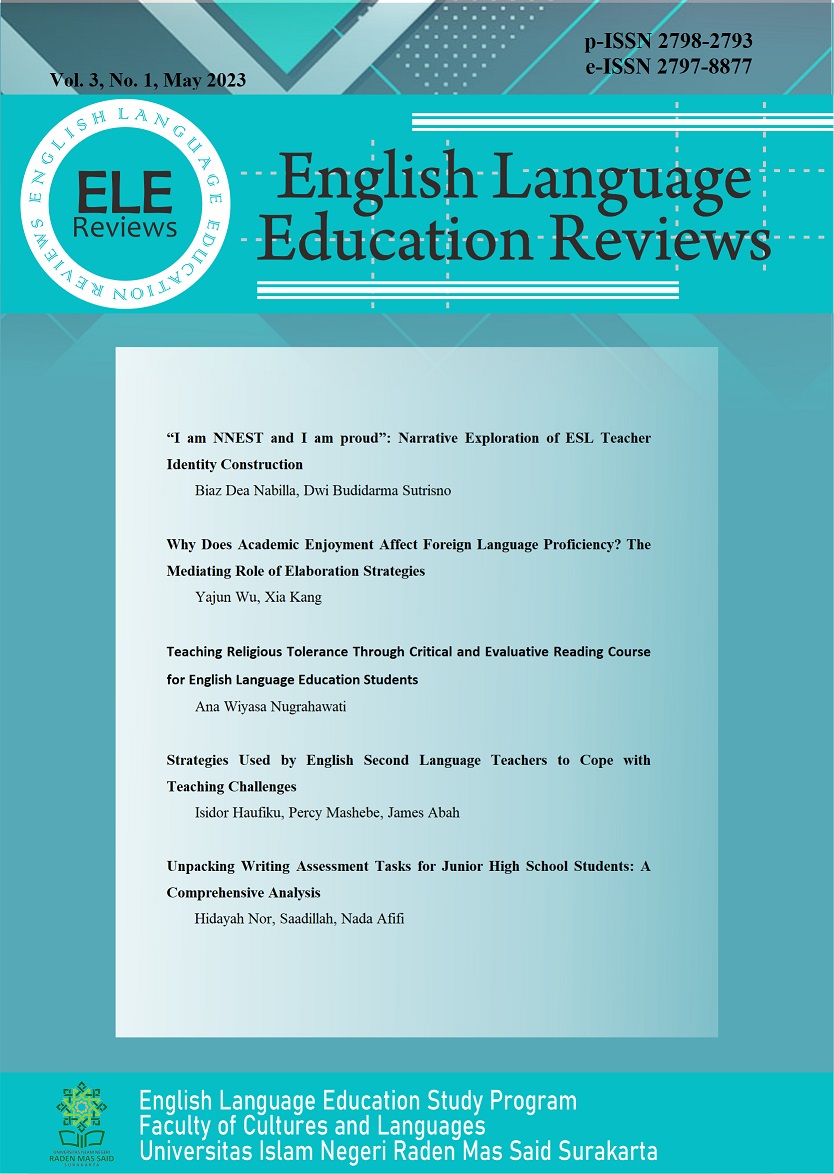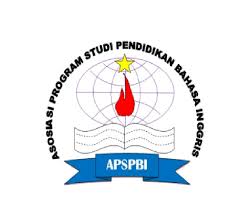Strategies Used by English Second Language Teachers to Cope with Teaching Challenges
DOI:
https://doi.org/10.22515/elereviews.v3i1.6886Keywords:
English second language, coping strategies, teachers, Ohangwena regionAbstract
The main aim of the study is to investigate the strategies used by English Second Language (ESL) teachers to cope with their specific teaching challenges in Senior Secondary Schools in Ohangwena Region, Namibia. The study used the phenomenological qualitative research design to collect data from a purposively selected sample of 33 ESL teachers who have taught for at least two years in the Ohangwena Region. Data were collected using focus group discussions and analyzed using the thematic analysis method. The study found that ESL teachers in Ohangwena Region mainly use strategies such as motivating learners, a learner-centered teaching approach, a group work teaching approach, teachers’ teamwork, and different sources of teaching materials to cope with their respective teaching challenges. While the coping strategies teachers use have been reported to be helpful in ESL teaching, there is still a need to build the teachers’ capacity on the good practices in using such strategies to mitigate their teaching challenges.
Downloads
References
Abebe, T. T., & Davidson, L. M. (2012). Assessing the role of visual teaching materials in teaching English vocabulary (Report). Language in India, 12(3), 524.
Akiba, M., & Liang, G. (2016). Effects of teacher professional learning activities on student achievement growth, The Journal of Educational Research, 109(1), 99-110. https://doi.org/10.1080/00220671.2014.924470
Al-Khairy, M. (2013). English as a foreign language learning demotivation factors as perceived by Saudi undergraduates. European Scientific Journal, 9(32), 365-379.
Al-Mahrooqi, R., Denman, C., Al-Siyabi, J., & Al-Maamari, F. (2015). Characteristics of a good EFL teacher: Omani EFL teacher and student perspectives, SAGE Open, 1-15. https://doi.org/10.1177/2158244015584782
Arkansas State University, (2020, May 13). The importance of teacher collaboration. https://degree.astate.edu/articles/k-12-education/importance-of-teacher-collaboration.aspx
Bahrani, T., & Soltani, R. (2012). What makes an English teacher stand out among others? Research on Human and Social Sciences, 2(2), 28-33.
Borko, H. (2004). Professional development and teacher learning: Mapping the terrain, Educational Researcher, 33(8), 3-15.
Carson, E., & Kashihara, H. (2012). Using the L1 in the L2 classroom: The learners speak. The Language Teacher, 36(4), 41-48. https://doi.org/10.37546/JALTTLT36.4-5
Celik, S. (2013). In the eyes of Turkish EFL learners: What makes an effective foreign language teacher? Porta Linguarum, 20, 287-297.
Ceka, A., & Murati, R. (2016). The role of parents in the education of children. Journal of Education and Paradise, 7(5), 61-64.
Chen, W. (2019). Patterns of pair interaction in communicative tasks: The transition process and effect on L2 teaching and learning. ELT Journal, 72(4), 425-434. https://doi.org/10.1093/elt/ccy015
Choi, S., Joh, J., & Lee, Y. (2008). Developing English discourse competence through self-directed practices of non-native English teachers. English Language & Literature Teaching, 14(2), 25-46.
Crawford, W. J., McDonough, K., & Brun-Mercer, N. (2019). Identifying linguistic markers of collaboration in second language peer interaction: A lexico-grammatical approach. TESOL Quarterly, 53(1), 180-207. https://doi.org/10.1002/tesq.477
Creswell, J. W. (2014). Research design: Qualitative, quantitative and mixed methods approaches (4th ed.). Sage.
Dewaele, J. M., & Al-Saraj, T. M. (2015). Foreign language classroom anxiety of Arab learners of English: The effect of personality, linguistic and socio biographical variables. Studies in Second Language Learning and Teaching, 5(2), 205-228. https://doi.org/10.14746/ssllt.2015.5.2.2
Durksen, T. L., Klassen, R. M., & Daniels, L. M. (2017). Motivation and collaboration: The keys to a developmental framework for teachers’ professional learning. Teaching and Teacher Education, 67, 53-66. https://doi.org/10.1016/j.tate.2017.05.011
Fatiloro, O. F. (2015). Tackling the challenges of teaching English language as a 2nd language (ESL) in Nigeria. IOSR Journal of the Research and Method of Education, 5(2), 26-30. https://doi.org/10.9790/7388-05212630
Freire, P. (1996). Pedagogy of the oppressed. Penguin.
García, L. J. (2011). Revisiting materials for teaching languages for specific purposes. 3L: The Southeast Asian Journal of English Language Studies, 17(1),102-112.
Garton, S., & Graves, K. (2014). Materials in ELT: Current Issues. In S. Garton & K. Graves (Eds.), International Perspectives on Materials in ELT (pp. 1-15). Palgrave Macmillan.
Government of the Republic of Namibia (GRN). (2017). Foundation for learning campaign. Government Notice No. 306, Gazette No. 30880.
Hamid. A. P., & Honan, C. (2018). The problem of difficulty in second language learning. University of Jordan.
Hargreaves, A. (2019). Teacher collaboration: 30 years of research on its nature, forms, limitations and effects. Teachers and Teaching, 1(19), 603-621. https://doi.org/10.1080/13540602.2019.1639499
Harris, P. (2011). Language in Schools in Namibia: The missing link in educational achievement? The Urban Trust of Namibia (1). Windhoek.
Harsono, Y. M. (2007). Developing learning materials for specific purposes. TEFLIN Journal, 18(2), 169-179.
Harwood, N. (2010). English language teaching materials: Theory and practice. Cambridge University Press.
Haufiku, I., Mashebe, P., & Abah, J. (2022). Teaching Challenges of English Second Language Teachers in Senior Secondary Schools in the Ohangwena Region, Namibia. Creative Education, 13, 1941-1964. https://doi.org/10.4236/ce.2022.136121
Iipinge, K. (2013). English lingua franca as language of learning and teaching in northern Namibia: A report on Oshiwambo teachers’ experiences. [Thesis, University Stellenbosch].
Jan, H. (2017). Teacher of 21st century: Characteristic and development. Research on Humanities and Social Sciences, 7(9), 50-54.
Johansson, T. (2006). Teaching material in the EFL classroom: Teachers’ and students’ perspectives. [Master’s thesis, Växjö University].
Karabuğa, F., & Ilin, G. (2019). Practicing lesson study in a Turkish education context: Considering the challenges, suggestions and benefits from EFL teachers’ perspectives. International Journal for Lesson and Learning Studies, 8(1), 60-78. https://doi.org/10.1108/IJLLS-05-2018-0036
Kelly, M. (2017). Second language teacher education. In Y. Y. Kim (Ed.), The International Encyclopedia of Intercultural Communication. John Wiley & Sons. https://doi.org/10.1002/9781118783665.ieicc0050
Kelly, C., Kelly, L., Offner, M., & Vorland, B. (2002). Effective ways to use authentic materials with ESL/EFL students. The Internet TESL Journal, 8(11). http://iteslj.org/Techniques/Kelly-Authentic.html
ken-Maduako, I., & Oyatogun, A. T. (2015). Application of team teaching in the English language class. Journal of Education and Practice, 6(29), 178-181.
Kepe, M. H., Foncha, J. W., & Maruma, M. W. (2017). Towards overcoming poor readership and building reading culture of in schools. Gender and Behaviour, 15(2), 8790-8797.
Khan, T. J., & Khan, W. (2016). Obstacles in learning English Language among intermediate, students of district, Mianwali & Bhakkar, Pakistan. Open Journal for Social Sciences, 4,154-162.
Khassawneh, S. F. (2011). The attitudes of students towards using Arabic in the EFL classroom at Yarmouk University in Jordan. European Journal of Social Science, 2(4), 592-602.
Kilickaya, F. (2004). Authentic materials and cultural content in EFL classrooms. The Internet TESL Journal, 10(7). http://iteslj.org/Techniques/Kilickaya-AutenticMaterial.html
Kini, T., & Podolsky, A. (2016). Does teaching experience increase teacher effectiveness? Palo Alto: Learning Policy Institute. https://files.eric.ed.gov/fulltext/ED606426.pdf
King, J. (2013). Silence in the second language classrooms of Japanese universities. Applied Linguistics, 34(3), 325-343. https://doi.org/10.1093/applin/ams043
Kitao, K., & Kitao, S. K. (1997). Selecting and developing teaching/learning materials. The Internet TESL Journal, 4(4).
Kong, Y. (2009). A Brief discussion on motivation and ways to motivate students in English language learning. International Education Studies, 2(2), 145-149.
Lecat, A., Raemdonck, I., Beausaert, S., & März, V. (2019). The what and why of primary and secondary school teachers’ informal learning activities. International Journal of Educational Research, 96, 100-110. https://doi.org/10.1016/j.ijer.2019.06.003
Lee, E., & Park, M. (2008). Student presentation as a means of learning English for upper intermediate to advanced level students. Journal of PanPacific Association of Applied Linguistics, 12(1), 47-60.
Little, J. W. (1990). The persistence of privacy: Autonomy and initiative in teacher’s professional relations. Teachers College Record, 91(4), 509-536.
Mai, N. K., & Iwashita, N. (2012). A comparison of learners’ and teachers’ attitudes toward communicative language teaching at two universities in Vietnam. University of Sydney Papers in TESOL, 7, 25-49.
Management Information System. (2020). Directorate of National Examinations and Assessment – DNEA. https://dailygistgh.com/directorate-of-national-examinations-and-assessment-dnea/
Manasreh, M. (2011). English in an Islamic cultural context: Students’ attitudes to English and advised practices [Paper presentation]. 44th Annual International ITEFL Conference, Harrogate.
Mathew, N. G., & Alidmat, A. O. H. (2013). A study on the usefulness audio-visual aids in EFL classrooms: Implications for effective instruction. International Journal of Higher Education, 2(2), 86-92. https://doi.org/10.5430/ijhe.v2n2p86
Meirink, J. A., Meijer, P. C., and Verloop, N. (2007). A closer look at teachers’ individual learning in collaborative settings. Teachers and Teaching: Theory and Practice, 13(2), 145-164. https://doi.org/10.1080/13540600601152496
Murphey, T., Falout, J., Fukuda, T., & Fukada, Y. (2014). Socio-dynamic motivating through idealizing classmates. System, 45, 242-253. https://doi.org/10.1016/j.system.2014.06.004
Opfer, V. D., & Pedder, D. (2011). Conceptualizing teacher professional learning. Review of Educational Research, 81(3), 376-407. https://doi.org/10.3102/0034654311413609
Pande, V. B. (2013). Problems and remedies in teaching English second language. Confluence, 416-421.
Phillipson, R., Foote, A., & Harper, C. (2018). Linguistic imperialism. Oxford University Press.
Prashanti, G., & Bhavani, D. K. (2016). Secondary school teachers’ perspectives on teaching pronunciation, accents and varieties. International Journal of English Language, Literature and Humanities, 4(1), 64-176.
Rondón, E. J., & Vera, L. F. V. (2016). Understanding the role of teaching materials in a beginners’ level English as a foreign language course: A case study. Profile Issues in Teachers’ Professional Development, 18(2), 125-137. https://doi.org/10.15446/profile.v18n2.52813
Saafin, M. S. (2005). An investigation into Arab students’ perceptions of effective EFL teachers at university level. [Unpublished Doctoral Thesis, University of Exeter].
Selim, M. A., & Tasneen, J. W. (2016). The problems of English language teaching at primary level in rural school of Bangladesh. [Unpublished Master’s Thesis, Institute of Education Research, University of Dhaka].
Shah, R. K. (2020). Concepts of learner-centred teaching. Shanlax: International Journal of Education, 8(3), 45-60. https://doi.org/10.34293/education.v8i3.2926
Shaw, V. N. (2001). Training in presentation skills: An innovative method for college instruction. Education, 122(1), 140-144.
Shishavan, B. (2010). The relationship between Iranian English language teachers’ and learners’ gender and their perceptions of an effective English language teacher. English Language Teaching, 3(3), 3-10. https://doi.org/10.5539/elt.v3n3p3
Simasiku, L. (2016). Is code switch complementary to English as medium of instruction in Namibian English second language classroom? Journal of University of Namibia Language Centre, 1(1), 12-26.
Sotto, E. (2011). When teaching becomes learning: A theory and practice of teaching (2nd ed.). Continuum Education.
Sugeng, B. & Suryani, A. W. (2018). Presentation-based learning and peer evaluation to enhance active learning and self-confidence in financial management classroom. Malaysian Journal of Learning and Instruction, 15(1), 173-201.
Tamo, D. (2009). The use of authentic materials in classrooms. LCPJ Journal, 2(1), 74-78.
Tang, N. K. (2020) Challenges and importance of teaching English as a medium of instruction in Thailand international college. Journal of English as an International Language, 15(2), 97-118.
Thomas, N., & Rose, H. (2019). Do language learning strategies need to be self-directed? Disentangling strategies from self-regulated learning. TESOL Quarterly, 53(1), 248-257. https://doi.org/10.2307/3586262
Thurlings, M., & den Brok, P. (2017). Learning outcomes of teacher professional development activities: A meta-study. Educational Review, 69(5), 554-576. https://doi.org/10.1080/00131911.2017.1281226
Tomlinson, B. (2012). Materials development for language learning and teaching. Language Teaching, 45(2), 143-179. https://doi.org/10.1017/S0261444811000528
Tuncel, H. (2015). The relationship between self-confidence and learning Turkish as a foreign language. Educational Research and Reviews, 10(18), 2575-2589. https://doi.org/10.5897/ERR2015.2445
Van Veen, K., Zwart, R. C., & Meirink, J. (2012). What makes teacher professional development effective? A literature review. In M. Kooy, & K. van Veen (Eds.), Teacher Learning that Matters: International Perspectives (Vol. 62, pp. 3-21). Routledge research in education, Routledge.
Zhang, O., & Watkins, D. (2007). Conceptions of a good tertiary EFL teacher in China. TESOL Quarterly, 41, 781-790.
Downloads
Published
How to Cite
Issue
Section
Citation Check
License
Copyright (c) 2023 Isidor Haufiku, Percy Mashebe, James Abah

This work is licensed under a Creative Commons Attribution-NonCommercial 4.0 International License.
Authors retain copyright and grant the journal right of first publication with the work simultaneously licensed under a Creative Commons Attribution License that allows others to share the work with an acknowledgement of the work's authorship and initial publication in this journal.
This ejournal system and its contents are licensed under
a Creative Commons Attribution-NonCommercial 4.0 International License








